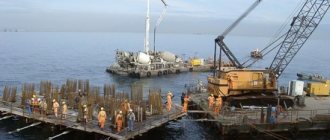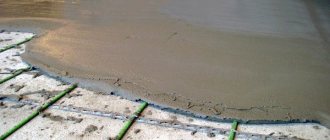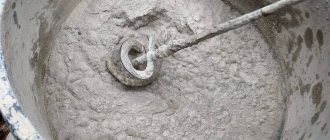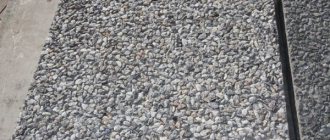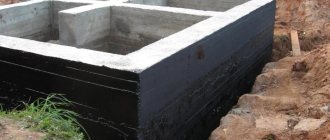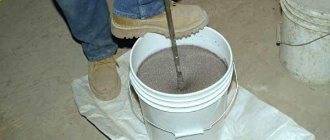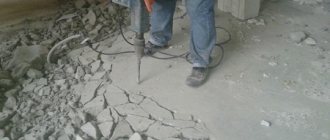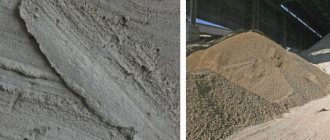Traditionally, “wet” processes include all activities related to the construction of buildings and structures that are associated with concreting, masonry work, plastering, etc. One of the main components necessary for preparing concrete mixtures and solutions directly on the construction site is water, which freezes at subzero temperatures.
In this part of the training course, we will talk about what nuances need to be taken into account when carrying out “wet” work in winter and how to properly use antifreeze additives.
Are there any advantages to winter concrete work?
In general, working with concrete in harsh conditions of low temperatures entails additional difficulties, but it is impossible to stop construction for six months every time autumn comes, and besides, winter work also has significant advantages:
- Winter discounts on building materials and the decline in demand for labor make it possible to save money.
- In winter, foundations can be concreted on weak or brittle soil.
- Frozen access roads make it possible to easily deliver heavy equipment and materials to a construction site.
The nuances of using antifreeze additives
It was already mentioned above that SP 70.13330 regulates the use of antifreeze additives. The fact is that antifreezes contain salts, and some additives, due to the presence of chlorides, can cause serious corrosion of steel reinforcement.
Each manufacturer has its own selection of additive components, but the main thing that a developer should remember when purchasing antifreeze additives is that he must choose a quality product from a well-established manufacturer. It should be written on the product packaging that the use of anti-frost additives in reinforced concrete structures is allowed.
Kirill Lebedev
If anti-frost additives are not used correctly in masonry mortars, in the spring, white stains (efflorescence) may appear on the facing brickwork. Therefore, you should strictly adhere to the manufacturer’s recommendations and use the dosage of antifreeze in strict accordance with the instructions.
Conclusions: The use of anti-frost additives ensures the continuity of the construction process at any external temperature and guarantees the quality and long service life of a country house. Although negative temperatures lead to increased costs associated with shorter working hours, additional costs for lighting, the need to heat workers and structures, etc., in winter prices for building materials, construction services, and equipment rentals decrease slightly. The cost of additives in the overall estimate for building a house is small. Therefore, with a competent approach, it is possible to bring the price of construction in winter and the price of construction in summer to a common denominator.
Features of winter concreting
In winter, the main enemy of high-quality concreting is low temperatures, which have a negative impact on the processes occurring both during concreting and during concrete hardening.
The formation of a solid substance - concrete - occurs as a result of the hydration reaction of the minerals that make up Portland cement. For this reaction to take place, a temperature above 0°C is necessary, since at negative temperatures water freezes and the hydration reaction stops.
Already at temperatures below 5°C, the reaction rate sharply slows down, and the strength gain of concrete slows down.
Low temperatures cause the following problems:
- cessation of the hydration reaction;
- increase in internal pressure due to freezing and associated expansion of the material;
- the formation of ice crystals around the reinforcement, which leads to poor adhesion to concrete;
- obtaining low-strength concrete.
The main task in winter is to ensure that the concrete reaches critical strength (30–50% of the design strength), after which negative temperatures no longer have a negative impact on concrete. Typically, under optimal conditions, critical strength is achieved 4–6 days after installation.
Therefore, in winter, temperature becomes of primary importance.
The temperature of the concrete mixture is measured before, during and after placement.
Important!
For winter concreting, it is recommended to use Portland cements and high-quality quick-hardening cements.
Thermos method
The technological essence of the “thermos” method is that the concrete mixture, which has a positive temperature (usually within 15...30°C), is placed in insulated formwork. As a result, the concrete of the structure gains a given strength due to the initial heat content and exothermic heat release of the cement during cooling to 0°C.
During the hardening process of concrete, exothermic heat is released, which quantitatively depends on the type of cement used and the curing temperature.
High-quality and fast-hardening Portland cements have the greatest exothermic heat release. The exotherm of concrete provides a significant contribution to the heat content of the structure maintained by the “thermos” method.
Therefore, when using the “thermos” method, it is recommended to use a concrete mixture based on highly exothermic Portland and quick-hardening cements, lay them at a high initial temperature and carefully insulate them.
Concreting using the “Thermos with accelerator additives” method
Some chemicals (calcium chloride CaCl, potassium carbonate - potash K2CO3, sodium nitrate NaNO3, etc.), introduced into concrete in small quantities (up to 2% of the cement mass), have the following effect on the hardening process: these additives accelerate the hardening process in the initial curing period of concrete. Thus, concrete with the addition of 2% calcium chloride by weight of cement already on the third day reaches a strength 1.6 times greater than concrete of the same composition, but without the additive. The introduction of accelerator additives, which are also anti-freeze additives, into concrete in the specified quantities lowers the freezing temperature to -3°C, thereby increasing the cooling time of concrete, which also helps concrete acquire greater strength.
Concrete with accelerator additives is prepared using heated aggregates and hot water. In this case, the temperature of the concrete mixture at the outlet of the mixer fluctuates between 25...35°C, decreasing to 20°C by the time of laying. Such concretes are used at outdoor temperatures of -15... -20°C. They are placed in insulated formwork and covered with a layer of thermal insulation. Hardening of concrete occurs as a result of thermos curing in combination with the positive effects of chemical additives. This method is simple and quite economical; it allows the use of the “thermos” method for structures with MP
Concreting "Hot thermos"
It consists of short-term heating of the concrete mixture to a temperature of 60... 80°C, compacting it while hot and holding it in a thermos or with additional heating.
Under construction site conditions, the concrete mixture is heated, as a rule, by electric current. To do this, a portion of the concrete mixture is included in an alternating current electrical circuit using electrodes as a resistance.
Thus, both the power released and the amount of heat released over a period of time depend on the voltage supplied to the electrodes (direct proportionality) and the ohmic resistance of the heated concrete mixture (inverse proportionality).
In turn, the ohmic resistance is a function of the geometric parameters of the flat electrodes, the distance between the electrodes and the specific ohmic resistance of the concrete mixture.
Electro-razofev of the concrete mixture is carried out at a voltage of 380 and less often 220 V. To organize the electro-razofev at the construction site, a post with a transformer (voltage on the low side is 380 or 220 V), a control panel and a switchboard is equipped.
Electric heating of the concrete mixture is carried out mainly in buckets or in the bodies of dump trucks.
In the first case, the prepared mixture (at a concrete plant), having a temperature of 5...15°C, is delivered by dump trucks to the construction site, unloaded into electric buckets, heated to 70...80°C and placed in the structure. Most often, ordinary tubs (shoes) with three electrodes made of steel 5 mm thick are used, to which the wires (or cable cores) of the power supply network are connected using cable connectors. To ensure uniform distribution of the concrete mixture between the electrodes when loading the bucket and better unloading of the heated mixture into the structure, a vibrator is installed on the body of the bucket.
In the second case, the mixture prepared at the concrete plant is delivered to the construction site in the back of a dump truck. The dump truck enters the heating station and stops under the frame with electrodes. With the vibrator running, the electrodes are lowered into the concrete mixture and voltage is applied. Heating is carried out for 10... 15 minutes until the temperature of the mixture is 60°C for quick-hardening Portland cements, 70°C for Portland cements, 80°C for Portland slag cements.
To heat the mixture to such high temperatures in a short period of time requires large electrical powers. Thus, to heat 1 m of mixture to 60°C in 15 minutes, 240 kW is required, and in 10 minutes - 360 kW of installed power.
Concreting technology in winter conditions
As part of the work project, activities are developed that ensure:
- Preventing concrete mortar from freezing during transportation, laying and compaction.
- Prevention of freezing of freshly laid concrete until critical strength is achieved.
- Favorable heat and humidity conditions for strengthening of hardening concrete.
Preparation of concrete in winter. Measures to prevent freezing of ready-mixed concrete during transportation, placement and compaction
The finished concrete mixture supplied to the construction site must have a temperature of at least 5°C. To do this, mixing is carried out in warm (up to 70°C) water, and the filling materials are heated.
Important!
The cement is not heated to avoid welding. The transportation time of the finished concrete solution should not exceed 4 hours.
Surfaces for concreting and reinforcement must be heated close to the temperature of the concrete solution, for which warm or hot air is used, but not steam or water.
When transporting the finished concrete mixture for a long time and it is impossible to use heating, antifreeze additives are used.
Measures to prevent freezing of concrete before reaching critical strength
There are two main methods of winter concreting:
- warm concrete;
- cold concrete.
Cold concrete is concrete that will harden without heating. To ensure its hardening, special antifreeze additives are designed to reduce the freezing point of water and at the same time accelerate hydration reactions so that the amount of unbound water in the solution decreases as quickly as possible.
Widespread antifreeze additives are electrolytes, Na and K salts, but their use has some limitations:
- sodium salts are not used in reinforced concrete, as they lead to corrosion of the reinforcement;
- some types of Portland cement (for example, highly alkaline or made from clinker with a high content of aluminosilicates) are not used in conjunction with electrolytes;
- sodium and potassium salts are not used in mixtures with potentially reactive rock filler;
- electrolyte salts should be tested experimentally for the formation of efflorescence.
Modern complex antifreeze additives do not have the disadvantages of electrolyte salts, provide the ability to carry out concrete work at low temperatures and have a complex effect (not only antifreeze, but also plasticizing and others).
Warm concrete is concrete that, after laying, is subjected to various heating and heating procedures.
Methods for heating concrete
After the concrete is laid and compacted, it is necessary to maintain an optimal temperature until critical strength is achieved, for which three types of measures are used:
- thermos method;
- construction of greenhouses;
- heating the concrete.
These measures are used both independently and in combination with antifreeze additives.
The choice of method depends on many factors:
- type of construction;
- composition of the concrete mixture;
- presence and type of fittings;
- presence or absence of appropriate equipment;
- economic expediency.
Heat conservation or "thermos method"
The thermos method is used in massive structures alone or in combination with accelerator additives. Accelerators contribute to faster hardening of concrete, which means that critical strength will be gained faster.
The hydration reaction is exothermic, that is, it occurs with the release of heat.
In massive structures, enough heat is released for heating, therefore, if you pour concrete into insulated formwork, and after pouring, cover it with PVC film and heat-insulating materials (mats, rolled materials, boards, foam), the concrete will maintain a temperature suitable for hardening up to a critical temperature strength.
Advantages of the method:
- energy saving;
- using concrete's own heat;
- relative simplicity.
Disadvantages of the thermos method:
- use only in massive structures;
- ineffectiveness at particularly low temperatures (solved by adding antifreeze additives);
- not suitable for designs with a large cooling surface area.
Hot dry thermos method
In this case, it is possible to lay concrete on a frozen base without heating. A layer of expanded clay heated to a temperature of 200–300°C is poured into the insulated formwork, and after it cools to 100°C, concrete mixed with warm water is laid. As a result, the heat from the cooling expanded clay is used to heat the concrete.
Construction of greenhouses
Teplyaks are a kind of tents that are installed above monolithic structures. Heat guns are installed inside the greenhouses in such a quantity as to ensure the required hardening temperature (above 5°C). The tightness of the shelter is of particular importance.
Methods for artificial heating of concrete
The highest rate of concrete hardening is at a temperature of 50°C.
It is possible to ensure the design temperature of concrete hardening until critical strength is achieved by using artificial heating of concrete using various methods:
- Electrode. Electrodes are fixed inside the formwork, which can be plate, strip, rod, or string. Heat is generated when current is passed through the concrete mixture.
- Conductive (contact). Heat is generated in the conductor when current passes through it and is transferred to the concrete mixture.
- Infrared. IR radiation is used to warm up the base, reinforcement and heat concrete without a heat carrier.
- Induction. Heat is generated by the fittings located in the electromagnetic field of the inductor.
The disadvantage of the methods is the need to use expensive equipment and electricity.
The use of anti-frost and accelerating additives allows concrete to quickly gain critical strength and thus save energy and increase equipment turnover.
Features of pouring concrete under different weather conditions
Pouring concrete in hot weather
Pouring concrete in scorching heat will be a real challenge for those who like to procrastinate.
The real test will be pouring concrete in scorching heat.
The floor hardens quickly, so you must adhere to certain rules:
- mandatory use of waterproofing. Even if it is not required due to weather conditions, its presence will not allow moisture to seep into the soil;
- a larger number of employees will increase the speed of work and ensure high-quality surface coverage;
- finishing the slab in two ways - with an aluminum float and a steel object - will provide a high-quality coating;
- to get a little extra time to complete the job, you should use a wetter mixture;
- You should start moistening the slab immediately after the treated surface has hardened.
Work in the cool season
When working in frosty weather, concrete hardens slowly. Once the slab is laid, you need to wait at least an hour before starting to grout by hand.
Due to the fact that performing this stage requires greater speed than the same actions on a hot day, you need to follow some tips:
- Do not moisten the concrete more than necessary;
- if weather conditions do not require the use of polyethylene waterproofing, it is worth allowing moisture to escape into the ground. This will speed up the hardening of the concrete;
- you should fill the area with the mixture as early as possible, this will ensure faster readiness for work, since during the day the air temperature is higher, and accordingly, the mixture hardens faster.
Concrete hardens slowly when working in frosty weather
Pouring concrete in cold weather
Pouring concrete at subzero temperatures requires the creation of special conditions. The solution should not freeze, otherwise the finely sanded surface of the slab will become mushy.
To ensure the best possible coverage when working in cold weather, there are a few things you need to remember:
- You should ask your supplier to mix the solution with warm water on days when the temperature is below freezing. This helps to avoid problems when transporting the mixture;
- the addition of quicklime to the mixture accelerates the initial hardening of concrete and will more firmly resist destructive factors during thawing or freezing. The amount of lime is usually 0.5 - 2% by weight of the mixture;
- It is important to remember that using a large amount of mixture is just as problematic as working in hot weather. The addition of lime makes the composition aggressive towards steel; this component cannot be used when working with concrete reinforced with steel structures;
- you should make sure that the crushed stone cushion is not frozen;
- it is necessary to provide additional heating to the building in which the work is being carried out;
- cover the finished slab with polyethylene and cover it with a layer of hay or straw more than 100 mm thick to provide thermal insulation.
Winter concrete at home
During home construction, concreting in conditions of negative temperatures is acceptable for objects of low importance.
For independent work, use kneading in heated (not higher than 70°C) water.
The order of laying the components of the concrete mixture is changed: first, coarse aggregate is poured into the water, then sand and cement.
Advice: In winter, it is recommended to use Portland cement of at least M400 grade.
At home, the use of heating concrete or installing greenhouses is not profitable; special anti-frost additives come to the fore, which make it possible to successfully carry out concrete work in winter.
Is it possible to add salt and modifying additives to concrete?
In winter, to lower the freezing point of free water, salt (sodium chloride) or other sodium and potassium salts, which act as electrolytes, are added to the concrete solution.
The use of salts can lead to corrosion of reinforcement and the appearance of efflorescence on finished concrete. The best option is to use complex antifreeze additives and plasticizers.
Warm styling technology
Heating of the laid mass and the surrounding area by external heat sources during the period when the monolith reaches critical density is called warm concreting. By heating the mass to 50 0 C, the rigidity and strength of the monolith quickly increases. Heating can be provided using electrical energy. Concrete dough is heated no higher than 70 degrees. Such conditions ensure rapid hardening of the monolith.
Apply:
- Electrode heating through the formwork, when heat is released when current passes through the concrete thickness.
- Infrared heating is applied to the reinforcement and special covering material, which warms up the array.
- They use grids of wires laid out on the surface of the poured mass, which generate heat when electricity passes.
- Induction method, when heat from the inductor is transferred to the monolith through the fittings.
All of these methods are energy-consuming, which negatively affects the cost of construction.
Application of heat guns
Tent heating is performed by supplying heated air or steam under a sealed dome installed above a concrete pie. Tested equipment – heat guns. The tent is an awning made of PVC material. The guns are installed inside, on a temporary frame. It takes up to 3 days to reach critical density using heat guns.
Possible consequences of winter concreting
Failure to comply with concrete laying technologies in winter results in concrete products of reduced strength, with cracks, efflorescence and other defects, as well as poor adhesion to reinforcement. The products are short-lived in use.
Important!
It should be remembered that the critical strength of concrete is 30–50% of the design strength, and stripping - 70%. Once concrete reaches critical strength, frost no longer harms it, and heating measures can be curtailed. But at this moment it is still impossible to strip the formwork and put a load on the concrete.
Concrete work in winter is most often a necessary measure, but even in this case there are advantages. When choosing a technology for winter work, many factors are taken into account: the type of structures, the composition of the concrete mixture, the availability of equipment and the economic effect of their use. Antifreeze additives are desirable for use when choosing any method of conducting concrete work in winter.
Methods of artificial heating and heating of concrete
The essence of this method is to create and further maintain the temperature of the mixture at the maximum permissible value until the concrete gains the required strength.
This method is used in cases where the “thermos” method is not enough. There are several options to achieve the desired result:
- Electrode
The physical meaning of electrode heating is similar to the above-described method of electrode heating of the mixture. In this case, the heat that is released by the mixture when an electric current is passed through it is used. To conduct electric current to concrete, several types of electrodes are used: plate, string, strip, rod. The most effective are plate electrodes made from roofing steel. The plates are sewn onto the surface of the formwork, which is in direct contact with the concrete, and connected to opposite phases of the network. Current exchange occurs between opposing electrodes, resulting in heating of the entire concrete structure.
- Conductive (contact)
The essence of contact or conductive heating is the use of heat generated in a conductor during the passage of electric current through it. By contact method, heat is transferred to all surfaces of the concrete element. From the surfaces, heat spreads throughout the structure. For contact heating of concrete, thermoactive flexible coatings or thermoactive formwork are used.
- Infrared The
infrared heating method is based on the ability of infrared rays, when absorbed by the body, to be transformed into thermal energy. Heat from the emitter to the heated body is carried out instantly without the use of a heat carrier. Quartz and tubular metal emitters are used as infrared wave generators. Infrared heating is used to warm reinforcement, frozen concrete surfaces, and thermal protection of laid concrete mixture.
- Induction
Induction heating uses the heat that is released in steel formwork or reinforcement parts and products located in the electromagnetic field of an inductor coil. This method is used to warm up previously made concrete structures at any ambient temperature and in any formwork.
To speed up the process of stripping and further loading the structure during the cold period, it is advisable to use a concrete class that is an order of magnitude higher to quickly gain normalized strength.
Compliance with the recommendations for winter concreting will help avoid loss of strength characteristics of concrete and reinforced concrete structures made at low outside temperatures.
Filling an armored belt at sub-zero temperatures
The reinforcing belt is designed to evenly distribute the load from the upper rows of masonry to the lower ones. It seems to connect the entire structure into a single whole. which significantly increases its overall strength and durability. The armored belt is made from steel rods laid around the perimeter, which must be welded together into a single structure.
When constructing a structure from gas silicate blocks, a reinforced belt is especially important. Such blocks quickly crack at the slightest movement of the soil or during shrinkage of the base. When installing a roof on such blocks, an armored belt is also necessary, since it is impossible to attach the timber to the blocks - they can crack. To avoid deformation of the walls and the building as a whole, a welded reinforced belt is simply necessary. It is welded into a solid structure, laid on top of the masonry and filled with concrete. It is sealed with mortar on both sides so as not to disturb the thermal insulation of the walls. Concreting of the belt is allowed in the cold season only using the above methods.
Working with concrete mixture at low temperatures is allowed in cases where there is no other option, because the optimal hardening temperature of the mass is from +5 degrees to 25.
At what temperature can concrete be poured in winter?
Without certain conditions, the solution will freeze at -4 degrees. Already at +5C, the hardening process slows down significantly, strength gain is canceled until it gets warmer. The bottom line is that the longer this period lasts, the worse the reliability indicators will be. Officially, the optimal temperature is approximately +20 degrees, but situations often arise when you need to build something at low degrees.
Concrete mortar consists of fillers - water, sand, crushed stone, cement. When cement is mixed with water, cement laitance is obtained, through which the components adhere, this is called hydration. At the same time, excess moisture evaporates and the mass hardens. In order for the stone base to turn out correctly, it needs to dry for 25 - 30 days. At first glance, it’s a lot and takes a long time, but it is in this period of time that a stone foundation is obtained that will not cause subsidence. It is advisable to protect the entire perimeter from precipitation or scorching sun, which are equally harmful to the solution.
During the cold period, permissible indicators for outdoor work fluctuate around - 15 degrees below zero. In this case, an important action is the use of antifreeze additives or other methods to warm up the mixture.
